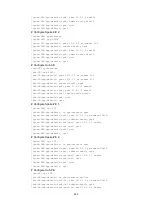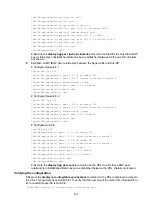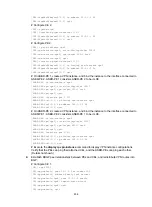
245
127.255.255.255/32 Direct 0 0 127.0.0.1 InLoop0
224.0.0.0/4 Direct 0 0 0.0.0.0 NULL0
224.0.0.0/24 Direct 0 0 0.0.0.0 NULL0
255.255.255.255/32 Direct 0 0 127.0.0.1 InLoop0
The output shows that PE 1 has a route to the remote CE. Output on PE 2 is similar.
# Verify that CEs of the same VPN can ping each other, whereas those of different VPNs cannot. For
example, CE 1 can ping CE 3 (10.3.1.1), but it cannot ping CE 4 (10.4.1.1). (Details not shown.)
Configuring MPLS L3VPN over a GRE tunnel
Network requirements
CE 1 and CE 2 belong to VPN 1. The PEs support MPLS. The P router does not support MPLS and
provides only IP features.
On the backbone, use a GRE tunnel to encapsulate and forward VPN packets to implement MPLS
L3VPN.
Configure tunnel policies on the PEs, and specify the tunnel type for VPN traffic as GRE.
Figure 72 Network diagram
Table 14 Interface and IP address assignment
Device
Interface
IP address
Device
Interface
IP address
CE 1
GE1/1/1
10.1.1.1/24
P POS1/1/0
172.1.1.2/24
PE 1
Loop0
1.1.1.9/32
POS1/1/1 172.2.1.1/24
GE1/1/1
10.1.1.2/24
PE
2 Loop0
2.2.2.9/32
POS1/1/1
172.1.1.1/24
GE1/1/1
10.2.1.2/24
Tunnel0
20.1.1.1/24
POS1/1/0 172.2.1.2/24
CE 2
GE1/1/1
10.2.1.1/24
Tunnel0
20.1.1.2/24
Configuration procedure
1.
Configure an IGP on the MPLS backbone to ensure IP connectivity within the backbone.
Loop0
Loop0
POS1/1/0
POS1/1/1
POS1/1/0
POS1/1/1
Tunnel0
Tunnel0
GE1/1/1
GE1/1/1
GE1/1/1
GE1/1/1
CE 1
CE 2
VPN 1
VPN 1
AS 65410
AS 65420
PE 1
PE 2
P
AS 100
GRE tunnel






























